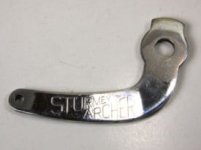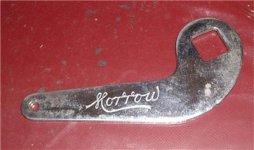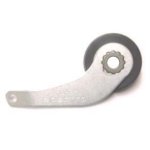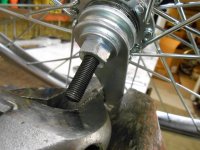First of all I'd like to say I'm not bashing farfle in any way just want to post this so people can avoid the problem that I have...
I posted my bike a while back when I was just starting to build it. I'm still working on it but I have been riding back and forth to work on it a few times over mostly roads with some pot holes and occasionally I cut through a grass field which was only a few hundred yards of bumpy riding. My motor starting acting like the halls were bad which was strange because I never disconnected them so they were definitely plugged in right. Pictures speak for themselves.


So it turns out a few blown hall sensors are the least of my worries. I'll list some factors that may have contributed to this failure:
-Didn't check axle nuts before ride. I checked them every ride for about a week and the last two days grew complacent and neglected to check them
-I have a massive controller... a zombiess 36 fet from the for sale section, however according to the email I got from zombiess when I bought it the batt amps were at 42 and the phase amps were set to 80. I understand that the controller probably did draw more current than that at times, but my idiot logic says 18s lipo (66.6v) at 42 amps = about 2.8kW which I figured would be well within the limits of the steel in the farfle swing arm.
Any comments or criticism are encouraged I want to prevent other people from this problem because my failure was not catastrophic but if it happened at a bad time (high speeds, in an intersection, etc.) I could have been seriously hurt or killed.
I posted my bike a while back when I was just starting to build it. I'm still working on it but I have been riding back and forth to work on it a few times over mostly roads with some pot holes and occasionally I cut through a grass field which was only a few hundred yards of bumpy riding. My motor starting acting like the halls were bad which was strange because I never disconnected them so they were definitely plugged in right. Pictures speak for themselves.


So it turns out a few blown hall sensors are the least of my worries. I'll list some factors that may have contributed to this failure:
-Didn't check axle nuts before ride. I checked them every ride for about a week and the last two days grew complacent and neglected to check them
-I have a massive controller... a zombiess 36 fet from the for sale section, however according to the email I got from zombiess when I bought it the batt amps were at 42 and the phase amps were set to 80. I understand that the controller probably did draw more current than that at times, but my idiot logic says 18s lipo (66.6v) at 42 amps = about 2.8kW which I figured would be well within the limits of the steel in the farfle swing arm.
Any comments or criticism are encouraged I want to prevent other people from this problem because my failure was not catastrophic but if it happened at a bad time (high speeds, in an intersection, etc.) I could have been seriously hurt or killed.






